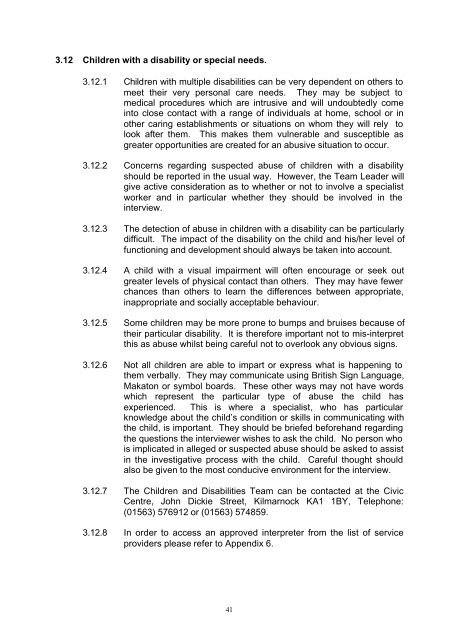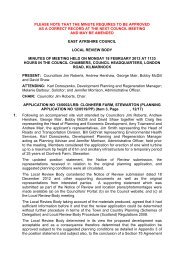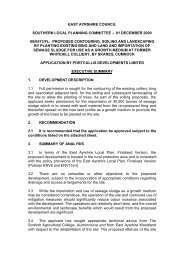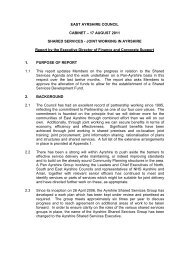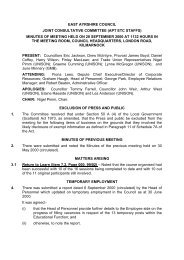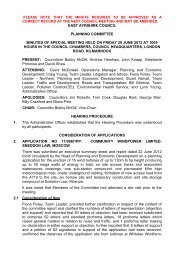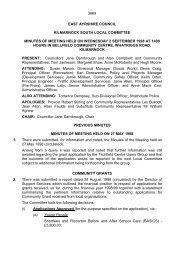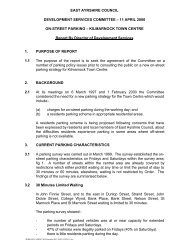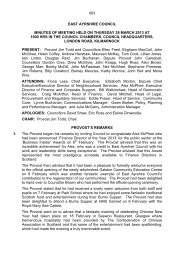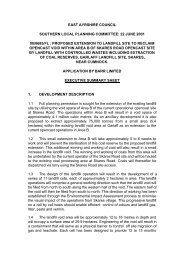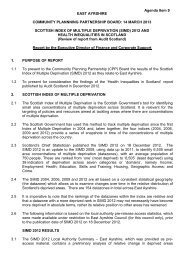Child Protection Procedures - East Ayrshire Council
Child Protection Procedures - East Ayrshire Council
Child Protection Procedures - East Ayrshire Council
Create successful ePaper yourself
Turn your PDF publications into a flip-book with our unique Google optimized e-Paper software.
3.12 <strong>Child</strong>ren with a disability or special needs.<br />
3.12.1 <strong>Child</strong>ren with multiple disabilities can be very dependent on others to<br />
meet their very personal care needs. They may be subject to<br />
medical procedures which are intrusive and will undoubtedly come<br />
into close contact with a range of individuals at home, school or in<br />
other caring establishments or situations on whom they will rely to<br />
look after them. This makes them vulnerable and susceptible as<br />
greater opportunities are created for an abusive situation to occur.<br />
3.12.2 Concerns regarding suspected abuse of children with a disability<br />
should be reported in the usual way. However, the Team Leader will<br />
give active consideration as to whether or not to involve a specialist<br />
worker and in particular whether they should be involved in the<br />
interview.<br />
3.12.3 The detection of abuse in children with a disability can be particularly<br />
difficult. The impact of the disability on the child and his/her level of<br />
functioning and development should always be taken into account.<br />
3.12.4 A child with a visual impairment will often encourage or seek out<br />
greater levels of physical contact than others. They may have fewer<br />
chances than others to learn the differences between appropriate,<br />
inappropriate and socially acceptable behaviour.<br />
3.12.5 Some children may be more prone to bumps and bruises because of<br />
their particular disability. It is therefore important not to mis-interpret<br />
this as abuse whilst being careful not to overlook any obvious signs.<br />
3.12.6 Not all children are able to impart or express what is happening to<br />
them verbally. They may communicate using British Sign Language,<br />
Makaton or symbol boards. These other ways may not have words<br />
which represent the particular type of abuse the child has<br />
experienced. This is where a specialist, who has particular<br />
knowledge about the child’s condition or skills in communicating with<br />
the child, is important. They should be briefed beforehand regarding<br />
the questions the interviewer wishes to ask the child. No person who<br />
is implicated in alleged or suspected abuse should be asked to assist<br />
in the investigative process with the child. Careful thought should<br />
also be given to the most conducive environment for the interview.<br />
3.12.7 The <strong>Child</strong>ren and Disabilities Team can be contacted at the Civic<br />
Centre, John Dickie Street, Kilmarnock KA1 1BY, Telephone:<br />
(01563) 576912 or (01563) 574859.<br />
3.12.8 In order to access an approved interpreter from the list of service<br />
providers please refer to Appendix 6.<br />
41


